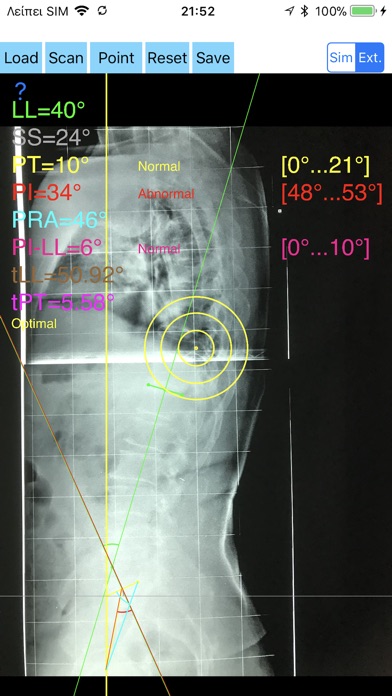
SpinopelvicBalanceApp
The assessment of the parameters involved in spinopelvic jucture are of paramount importance for spine and joint replacement surgeon. The dynamic interplay between flexibility and balance around the axis of gravity determine the type and the amount of influence in spine and hips. Radiographic parameters to evaluate objectively the spinopelvic sagittal balance are Pelvic incidence (PI), Sacral slope (SS), Pelvic Tilt (PT), Lumbar lordosis (LL). Drawings in patients X-rays and precise measurements are important in order to quantify the magnitude of spinal deformities, to monitor the success or failure of treatment and thus optimise the management of patients according to the severity of the imbalance or even to identify patient at risk of degenerative spondylolisthesis or disk herniation.
The Spinopelvic Balance App is medical software aimed for orthopaedic surgeons, providing tools that allow doctors to:
-Securely import medical images directly from the camera or stored photos.
-By marking few points at the image of X-ray, the App calculates and offers a very convenient way to determine the most accurate possibly way at once, Pelvic incidence (PI), Sacral slope (SS), Pelvic Tilt (PT), Lumbar lordosis (LL), thoracic kyphosis, PI–LL Pelvic incidence Angle (PI) minus Lumbar lordosis Angle (LL) PI–LL, theoretical normal pelvic tilt (tPT),theoretical normal L1-S1 lumbar lordosis (tL1S1), Pelvic Radius Angle (PRA). According to measured parameters the app categorises the severity of the imbalance of spine, in different stages: optimal or non optimal.
-Save the planned images, for later review or consultation.The measured values are compared by normal reference databases and also data are exported as txt file, ready to print or to input as cells to excel for research.
-The app allows choosing between simple and extended method according to everyday preference and also by choosing points in vertebra body in a independent manner from order.
-The app can be used to measure L5 Incidence (L5I) Angle or L4 respectively.
-The app offers theoretical value estimation this is particularly useful because a sensible difference between theoretical value and measured value reveals a compensation phenomenon if the pelvis tilt (PT) is higher than its theoretical value, then it is due to pelvis retroversion, which is a compensation phenomenon. Knowing the theoretical value of Pelvis Tilt (PT) provided it is easy to understand that a sensible difference between theoretical value and measured value is a compensation phenomenon.
All information received from the software output must be clinically reviewed regarding its plausibility before patient treatment! Spinopelvic Balance App indicated for assisting healthcare professionals. Clinical judgment and experience are required to properly use the software.The software is not for primary image interpretation.
In a busy everyday practice, the examiner have to draw lines in X-rays or in clinical settings, this it is time consuming and cumbersome. Accessory instruments like protractors, hinged goniometers, well sharped pencils, rulers or even transparent papers must be available. The app offers a very convenient and accurate way to perform most common radiographic measurements for spine, at the spinopelvic juncture in a blink of an eye in front of your screen. The build in feature of the app, allows results to be categorized may help decide what could be considered normal or pathologic.
The app is not a simple goniometer, is an enhanced product which helps to monitor objectively the course of the treatment and evaluate optimally the spine. This App is particular useful in clinical settings where you need a quick results without losing time.Please see tutorial videos at the developer’s web
Reference
1.Nunes VR, et al.Spinopelvic balance evaluation of patients with degenerative spondylolisthesis L4L5 and L4L5 herniated disc who underwent surgery.Rev Bras Ortop. 2016 Sep 22;51(6):662-666.



